Contacts from several communities and industries noted recently that heightened uncertainty is weighing on their decision making in various ways. The recent rise in uncertainty has several drivers, including trade policy uncertainty, monetary policy uncertainty, other fiscal policy changes, as well as uncertainties about potential changes in economic fundamentals. The consequences of these uncertainties are evident in recent shifts in consumer sentiment, business expectations, and asset market volatility. Current economic data are just beginning to show how households and businesses may be adjusting their behavior in the face of greater uncertainty, but the extent of these shifts will require some time to monitor before they are fully understood.
Heightened uncertainty resulting from various drivers can be difficult to track and understanding its implications for the economic outlook can be even more of a challenge. This edition of the Rocky Mountain Economist provides a digest of work by Kansas City Fed researchers on how uncertainty can influence the outlook and highlights recent activities of regional businesses during the current period of heightened uncertainty. Past research shows how rising economic uncertainty and financial volatility act like an adverse demand shock, slowing household consumption and business investment activity. Alternatively, trade barriers and trade policy uncertainty give rise to a distinct supply shock, raising the costs of production along integrated supply chains. Timely information from regional businesses indicates current economic activity is indeed adjusting consistent with past experiences of heightened uncertainty.
Heightened Uncertainty Tends to Reduce Overall Demand
From Basu, Susanto and Brent Bundick (2016) “Uncertainty Shocks in a Model of Effective Demand,” Federal Reserve Bank of Kansas City Research Working Paper Series, 14-15
In this article, the authors Basu and Bundick show that heightened uncertainty is often large enough in its implications to lead to macroeconomic fluctuations by reducing aggregate demand. Specifically, they show an uncertainty shock causes significant declines in output, consumption, investment and hours worked. The decline in output associated with uncertainty shocks is somewhat persistent, peaking after a year with a typical duration of around 3 years. Related work in Bundick (2019) similarly shows output tends to contract following periods of heightened financial market volatility. Chart 1 shows the volatility of expected stock returns measured by the VIX index has been elevated recently, consistent with the circumstances of an uncertainty shock in the U.S. economy. (Panel A) Chart 1 also includes a replication of the results from Basu and Bundick regarding the changes in U.S. consumption that typically occur following an uncertainty shock in Panel B. Consumption tends to decline following a sudden rise in uncertainty and remains subdued for several quarters.
Chart 1: Past Episodes of Heightened Uncertainty and Changes in Aggregate Demand
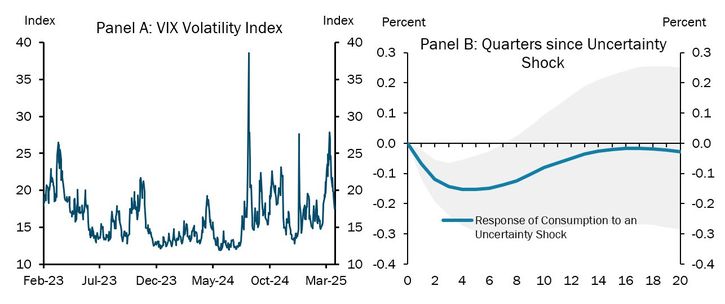
Sources: Chicago Board Options Exchange, HAVER, Basu and Bundick (2016)
Current economic dynamics appear consistent with the typical effects of uncertainty discussed in this past research. Chart 2 shows timely information from Federal Reserve business surveys across various regions, where the blue line represents the average across surveys. These timely indicators of business activity highlight the moderation in planned capital expenditures being reported in recent weeks. (Panel A) Businesses’ expectations about the outlook have also softened recently as concerns about customer demand have become more elevated. (Panel B) The recent declines in capital plans and sentiment were each from elevated levels. Overall, expectations remain slightly positive. More time is needed to determine if business activity is merely moderating from recent highs or if growth is trending downward.
Chart 2: Current Uncertainty and Changes in Business Expectations and Investment Activity
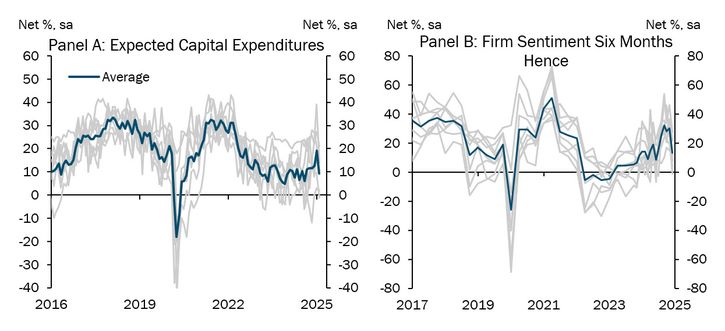
Sources: Kansas City Fed Surveys, New York Fed Surveys, Dallas Fed Surveys, Philadelphia Fed Surveys, Richmond Fed Surveys, staff calculations
Note: The blue line indicates the average of the various Federal Reserve Banks Surveys, while each gray line represents information from individual Reserve Bank surveys. The data in Panel A are shown at a monthly frequency, while the data in Panel B are shown at a quarterly frequency up to January 2024 and monthly thereafter to highlight recent developments.
Global Uncertainty Raises Headwinds to U.S. Exports
From Sly, Nicholas (2016) “Global Uncertainty and U.S. Exports,” Federal Reserve Bank of Kansas City Economic Review
The effects uncertainty has on demand are not necessarily contained within borders. Heightened uncertainty about global growth conditions and greater financial market volatility in foreign markets often result in lower demand for U.S. exports, and vice versa. For example, during the period between 2011 and 2015, global growth levels were relatively steady but confidence about the recovery following the global financial crisis was rising. As uncertainty waned in many countries, particularly during 2013, U.S. exports to those markets rose. Chart 3 is a replication of results in Sly (2016) that shows the contributions to U.S. export growth during a period of declining uncertainty. These results can serve as a historical example of how uncertainty also weighs on demand in the export sector.
Chart 3: Uncertainty about Foreign Growth Has Been a Key Driver of U.S. Export Growth in the Past
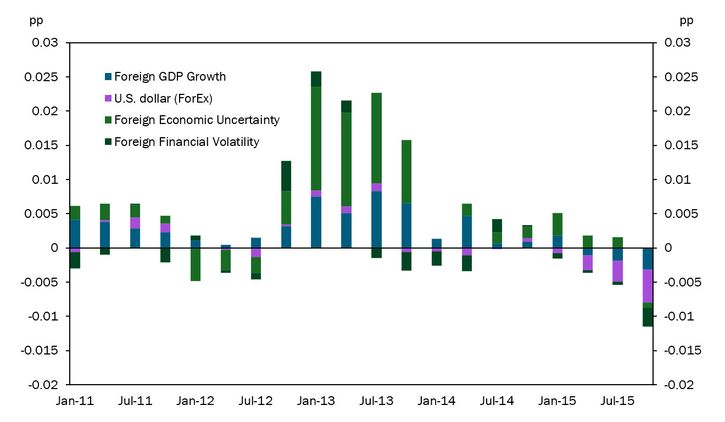
Source: Sly (2016)
Note: Each colored bar represents the estimated contribution of changes in distinct economic fundamentals to the percentage change in aggregate U.S. exports on a quarterly basis.
Trade Costs and Trade Policy Uncertainty Are Also Influencing the Outlook
Another prominent source of uncertainty currently concerns trade policy. The KC Fed’s annual Economic Symposium in Jackson Hole was on the topic “Fostering a Dynamic Global Economy” in 2017. Panelists at that symposium discussed research highlighting the substantial consequences arising from trade policy uncertainty for U.S. employment and investment outcomes, separate from the effects of actual trade costs. Specifically, uncertainty about trade policy can influence the organization of supply chains, inventory management decisions, and hiring activity. Chart 4 shows a measure of trade policy uncertainty based on media mentions, related policy details, and surveys of professional forecasts. The most recent data indicates that trade policy uncertainty is now at level unseen in several decades.
Chart 4: Trade Policy Uncertainty
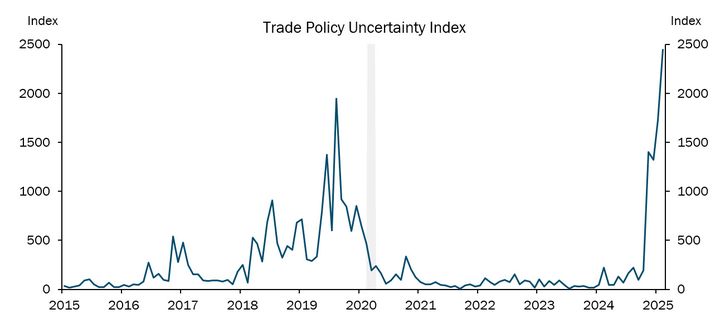
Sources: Baker, Scott R.; Bloom, Nick; Davis, Stephen J., FRED
Chart 5 shows that firms in the KC Fed region are currently anticipating trade policy adjustments will raise their costs over the coming year, with the majority of respondents indicating it will push costs and prices higher or significantly higher. (Panel A) In contrast, regional firms are mixed in their expectations of demand in the wake of changing trade costs. Some firms expect higher demand due to domestic market protections while others anticipate lower demand as cost pressures squeeze competitiveness. However, the most common response was that demand conditions are not expected to change as a result of anticipated trade costs. (Panel B) The distinction between firms’ expectations about demand and expectations about their costs highlights how trade policy uncertainty has implications that are different from general economic uncertainty and financial market volatility; trade policy uncertainty appears as a cost shock that affects firms’ willingness and ability to produce and sell into prevailing market conditions.
Chart 5: Regional firms report mixed expectations for demand but generally expect trade policy to push costs higher
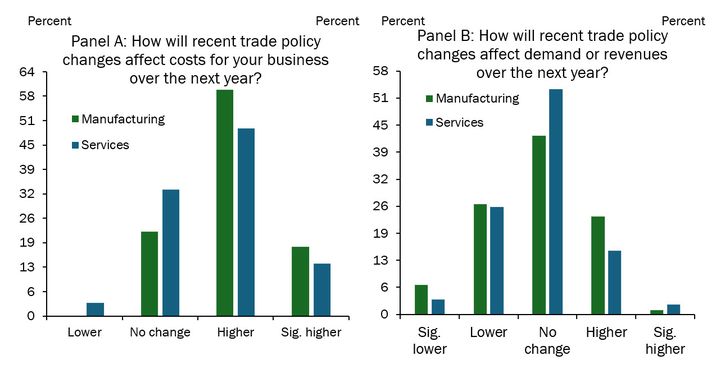
Sources: Kansas City Fed Surveys
Looking ahead
Peering through the fog of uncertainty can be difficult for businesses, policymakers and households. Past research provides a useful lens to view the variety of uncertainties weighing on the outlook currently. The fact that recent changes in activity among businesses appear to align with historical experiences suggest past episodes can be a useful guide. An ongoing challenge will be to monitor how the balance of different sources of uncertainty will weigh on the outlook in their totality. For example, if demand were to slow significantly in the face of aggregate uncertainty, price pressures may ease somewhat. However, as trade policy uncertainty leads to higher costs, price pressures will rise. Moreover, the balance of these two uncertainties on price pressures may change over time as conditions evolve and the persistence of their influence on price pressures vary.
